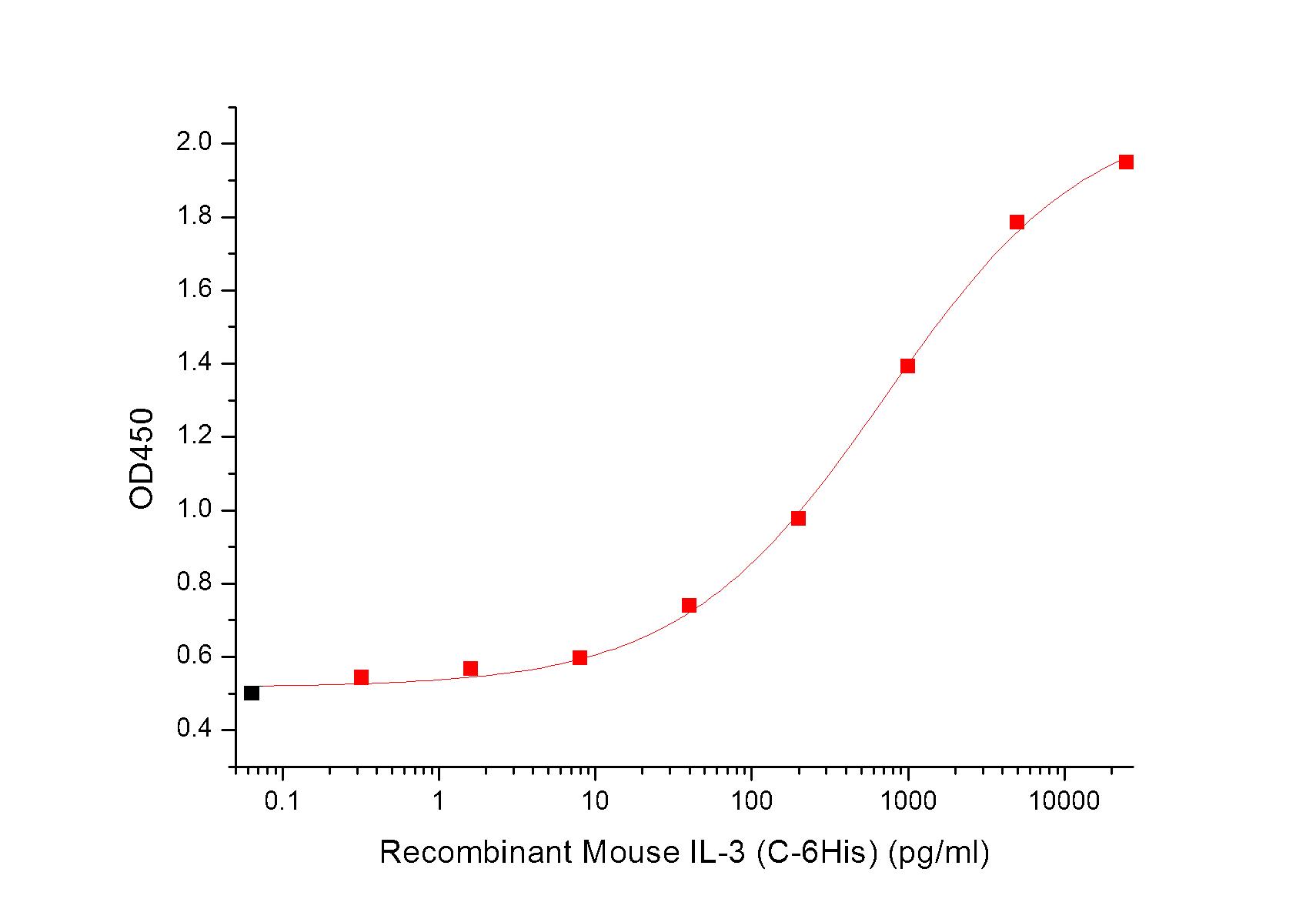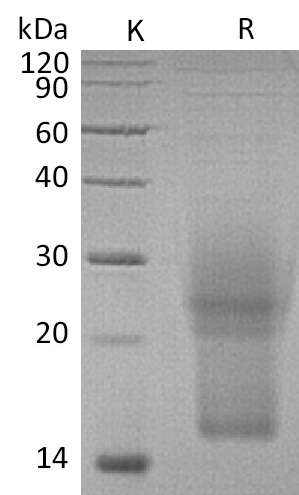- Remove All
 Your shopping cart is currently empty
Your shopping cart is currently empty
IL-3 Protein, Mouse, Recombinant (His)
Interleukin 3 is a pleiotropic factor produced primarily by activated T cells that can stimulate the proliferation and differentiation of pluripotent hematopoietic stem cells as well as various lineage committed progenitors. In addition, IL-3 also affects the functional activity of mature mast cells, basophils, eosinophils and macrophages.Because of its multiple functions and targets, it was originally studied under different names, including mast cell growth factor P-cell stimulating factor, burst promoting activity, multi-colony stimulating factor, thy-1 inducing factor and WEHI-3 growth factor. In addition to activated T cells, other cell types such as human thymic epithelial cells, activated mouse mast cells, mouse keratinocytes and neurons/astrocytes can also produce IL-3. IL-3 exerts its biological activities through binding to specific cell surface receptors. The high affinity receptor responsible for IL-3. signaling is composed of α and βsubunits. IL-3 is capable of supporting the proliferation of abroad range of hematopoietic cell types. It is involved in avariety of cell activities such as cell growth, differentiation and apoptosis. IL-3 has been shown to also possess neurotrophic activity, and it may be associated with neurologic disorders.

IL-3 Protein, Mouse, Recombinant (His)
| Pack Size | Price | Availability | Quantity |
|---|---|---|---|
| 10 μg | $118 | In Stock | |
| 50 μg | $350 | 7-10 days | |
| 500 μg | $1,330 | 7-10 days | |
| 1 mg | $2,970 | 7-10 days |
Product Information
| Biological Activity | Measured in a cell proliferation assay using NFS‑60 mouse myelogenous leukemia lymphoblast cells. The ED50 for this effect is 582 pg/ml. (Regularly tested)  |
| Description | Interleukin 3 is a pleiotropic factor produced primarily by activated T cells that can stimulate the proliferation and differentiation of pluripotent hematopoietic stem cells as well as various lineage committed progenitors. In addition, IL-3 also affects the functional activity of mature mast cells, basophils, eosinophils and macrophages.Because of its multiple functions and targets, it was originally studied under different names, including mast cell growth factor P-cell stimulating factor, burst promoting activity, multi-colony stimulating factor, thy-1 inducing factor and WEHI-3 growth factor. In addition to activated T cells, other cell types such as human thymic epithelial cells, activated mouse mast cells, mouse keratinocytes and neurons/astrocytes can also produce IL-3. IL-3 exerts its biological activities through binding to specific cell surface receptors. The high affinity receptor responsible for IL-3. signaling is composed of α and βsubunits. IL-3 is capable of supporting the proliferation of abroad range of hematopoietic cell types. It is involved in avariety of cell activities such as cell growth, differentiation and apoptosis. IL-3 has been shown to also possess neurotrophic activity, and it may be associated with neurologic disorders. |
| Species | Mouse |
| Expression System | HEK293 Cells |
| Tag | C-6xHis |
| Accession Number | P01586 |
| Synonyms | P-cell-stimulating factor,Multipotential colony-stimulating factor,MCGF,Mast cell growth factor,Interleukin-3,IL-3,Il3,Hematopoietic growth factor |
| Amino Acid | Ala27-Cys166 |
| Construction | Ala27-Cys166 |
| Protein Purity | Greater than 95% as determined by reducing SDS-PAGE. Greater than 95% as determined by SEC-HPLC.   |
| Molecular Weight | 15-32 KDa (reducing condition) |
| Endotoxin | < 0.001 ng/µg (0.01 EU/µg) as determined by LAL test. |
| Formulation | Lyophilized from a solution filtered through a 0.22 μm filter, containing PBS, pH 7.4. |
| Reconstitution | Reconstitute the lyophilized protein in distilled water. The product concentration should not be less than 100 μg/ml. Before opening, centrifuge the tube to collect powder at the bottom. After adding the reconstitution buffer, avoid vortexing or pipetting for mixing. |
| Stability & Storage | Lyophilized powders can be stably stored for over 12 months, while liquid products can be stored for 6-12 months at -80°C. For reconstituted protein solutions, the solution can be stored at -20°C to -80°C for at least 3 months. Please avoid multiple freeze-thaw cycles and store products in aliquots. |
| Shipping | In general, Lyophilized powders are shipping with blue ice. Solutions are shipping with dry ice. |
| Research Background | Interleukin 3 is a pleiotropic factor produced primarily by activated T cells that can stimulate the proliferation and differentiation of pluripotent hematopoietic stem cells as well as various lineage committed progenitors. In addition, IL-3 also affects the functional activity of mature mast cells, basophils, eosinophils and macrophages.Because of its multiple functions and targets, it was originally studied under different names, including mast cell growth factor P-cell stimulating factor, burst promoting activity, multi-colony stimulating factor, thy-1 inducing factor and WEHI-3 growth factor. In addition to activated T cells, other cell types such as human thymic epithelial cells, activated mouse mast cells, mouse keratinocytes and neurons/astrocytes can also produce IL-3. IL-3 exerts its biological activities through binding to specific cell surface receptors. The high affinity receptor responsible for IL-3. signaling is composed of α and βsubunits. IL-3 is capable of supporting the proliferation of abroad range of hematopoietic cell types. It is involved in avariety of cell activities such as cell growth, differentiation and apoptosis. IL-3 has been shown to also possess neurotrophic activity, and it may be associated with neurologic disorders. |
Dose Conversion
Calculator
Tech Support

Copyright © 2015-2025 TargetMol Chemicals Inc. All Rights Reserved.


